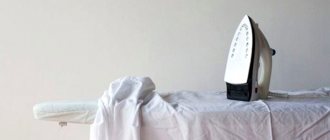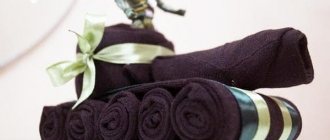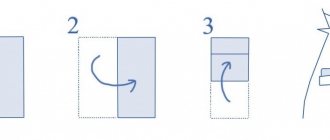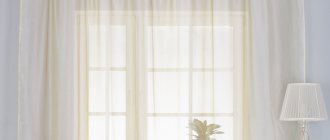Stretch bedding appeared relatively recently, but has already acquired an army of fans who have seen a lot of advantages in them. And this is not surprising: such underwear is easy to put on the mattress, does not twist or slide at night, wrinkles less, and in the morning it looks as if it had just been laid on. Although one problem still remains: how to fold a sheet with an elastic band correctly so that it fits compactly in the closet and does not acquire unsightly folds and creases? Fortunately, it can be solved, and in several simple ways.
Method 1 step by step - photos and videos
This method is considered the most effective. It will help you save space in your closet and reduce the time it takes to iron your bed linen.
So, fold the sheet with an elastic band (step by step):
- Run your fingers into the corners of the sheet along the long side and stretch it.
- Place one corner inside the other. Smooth out the resulting loop and hold it tightly.
- With your free hand, pick up the remaining two corners from below and thread one into the other in the same way.
- Straighten your arms and pull the sheet up (you should have a loop of two corners in each hand).
- Pass one loop through the other again and shake the resulting rectangle.
- Lay the sheet out on a flat surface and smooth out any wrinkles.
- Fold the fitted sheet lengthwise and then crosswise (folding towards the middle).
At first glance, it may seem that folding a sheet so as not to wrinkle it is very difficult. However, there is nothing complicated about this process. It is important to be consistent, go slowly and carefully straighten the corners.
Let's look at how to fold a sheet with an elastic band, step by step in the photo below:
How to fold a sheet with an elastic band - video demonstrating the first method:
Iron folding method
Of course, this product has a number of advantages. But caring for him is not always easy. In some situations you have to fold laundry using an iron. Not all housewives like this idea. Therefore, now we will discuss all the intricacies of ironing this kind of linen.
It's no secret that quite often manufacturers overprice their products. For example, some of them provide sheets while loudly shouting about not having to iron the sheets. But as it turns out, there are more than enough problems with this kind of product. One of them is the impossibility of achieving an ideal surface even with an iron. But if you value your investment, nerves and time, you should pay attention to a quality manufacturer. But in general, this moment is not the main thing for everyone - ironing the sheets. But for people with more strict aspects of life, this moment cannot be missed. Therefore, further we will consider alternative options for correctly folding a sheet with an elastic band using an iron.
Note! Not every fitted sheet should be ironed. For example, terry fabric loses its properties when ironed. And over time it stops being so soft. You can find out what temperature corresponds to a particular sheet by looking at the label on the product itself. It is usually sewn somewhere on the inside of the sheet.
Ironing a sheet is a whole procedure that has its own specific rules. But why should you iron a fitted sheet with an iron? Is it even worth doing? Below are reasonable arguments that will motivate you to iron your product correctly. For example, the following problems may occur due to improper ironing:
- the product will lose its former beautiful appearance;
- turn into an unusable thing before the established deadline;
- there will no longer be that same fresh smell that usually occurs after washing the sheets;
- the linen will become coarser and it is unlikely that anyone will want to sleep on a damaged sheet;
- will lose color, various folds and other defects will appear that cannot be easily eliminated (in some cases, such problems cannot be solved at all).
As you can see, these reasons are very significant and it will be a great pity if you spend a lot of money and the product does not last as long as it should. Therefore, now we will consider the basic methods of proper ironing.
How to properly iron a fitted sheet?
Just a few convenient methods. The housewife will only need to choose a more suitable option for herself and work according to the same algorithm. Well, let's look at each of these methods in detail:
- Method number 1. It is better to smooth out the central part of the sheet from the very beginning. Because corners are always difficult to smooth to an absolutely flat surface. It doesn’t matter how many hours it takes, but the desired result will not be achieved.
- Method number 2. The simplest, but ideal option is to smooth the sheet on the mattress itself. So it will be possible to minimize the occurrence of unnecessary folds. But it is important to consider the fabric material itself. If it is of low quality, it won’t be long before you burn the mattress.
- Method number 3. There is another method - ironing in a circle. The first step is to smooth out the middle. The second step is to start on one side and smooth around the perimeter. This will allow you to notice minor wrinkles so that you can get rid of them using this simple method.
The above methods are effective and work well if you follow a clear plan. This will help save your nerves, strength and satisfy your desire to sleep on a flat and soft sheet.
Method 2
The second life hack, how to neatly and beautifully fold a sheet with an elastic band, is almost identical to the first method, but the process itself is different:
- To begin, straighten the sheet and fold it in half, turning the corners on one side inside out and inserting them into the corners on the other side.
- Then they stick their hands into the resulting corners, lean them against each other and turn one of the sides so that the corners are inside the opposite corners.
- The bedding is laid horizontally with the elastic at the top and folded 3 times, starting from the bottom.
- Then, holding one edge, roll it up in several layers so that you get an even rectangle.
How to iron step by step
Ironing the sheets is no less difficult. Some housewives “omit” this stage, but this is wrong - ironing clothes helps to destroy any unhealthy microflora on the material, which significantly extends the life of the product. And it’s much more pleasant to sleep on ironed clothes than on wrinkled ones.
To quickly iron your sheets, try adding a little fabric softener to the washing powder - this will soften the material. Under no circumstances should you leave a washed sheet in the drum of a washing machine after spinning - if you do not straighten it immediately, then it will be almost impossible to smooth out such a sheet in the future.
Before hanging bedding on the line, carefully straighten the sheet and shake it out. Remove the fitted sheet immediately after the fabric has dried. And after removing it, carefully inspect and sew up any holes if any appear - otherwise they may increase under a hot iron.
Keep in mind that different types of fabric have different ironing temperatures. So, silk is ironed at 80 degrees, viscose at 120, for chintz the iron is set at a heating level of 170 degrees, for cotton a temperature of 180 degrees is suitable, and for linen a maximum heating of 200 degrees is needed.
After the fabric and iron are ready, you need to start ironing.
Usually the elastic is sewn to the sheet around the entire perimeter or only in the corners - in the second case, there are no special problems with ironing, but in the first case the process will be much more troublesome. Experienced housewives were able to identify 4 basic methods for caring for fitted sheets.
Method 1
In this case, the sheet should be folded exactly in half lengthwise, and then repeat the manipulations, but across. After this, you should process its outer sides, then unfold it back and fold it again so that the “former” inner side is on top - and iron it again.
This is a simple method that gives high quality heat treatment, however, you will not get ideal smoothness this way.
Method 2
The sheet should be placed on the mattress and ironed in this form. Such ironing will not only completely neutralize bacteria and achieve sterility, but will also create a perfectly smooth surface that will be comfortable for sleeping.
In addition, this processing goes quite quickly, since many small folds straighten themselves when pulled. However, this is only possible if the length of the iron cord allows ironing to be carried out in exactly this way.
Method 3
This is the highest quality option, but at the same time the most labor-intensive. To achieve the best ironing, you need to unfold the product and run the iron along its central part, after which the edges of the sheet need to be pulled over the corner of the ironing board and slowly ironed, smoothly moving the material around the circumference.
Method 4
This option involves ironing without an iron at all. In order to smooth out linen with an elastic band, you just need to carefully fold the sheet into a pile and place it under a heavy press, for example, under tablecloths, bath towels and other washed and folded items.
It is important that the laundry is completely dry. Some people iron a fitted sheet with an ordinary hand steamer - this should not be done, since vertical steam treatment is not entirely convenient, and if you iron the fabric on the mattress, it will absorb moisture and begin to rot from the inside
This will lead to the formation of fungi and dangerous mold, which have adverse effects on the health of children and adults.
Some people iron a fitted sheet with an ordinary hand steamer - this should not be done, since vertical steam treatment is not entirely convenient, and if you iron the fabric on the mattress, it will absorb moisture and begin to rot from the inside. This will lead to the formation of fungi and dangerous mold, which have adverse effects on the health of children and adults.
A stretch knitted sheet with an elastic band is very convenient to use, but caring for it and organizing its storage poses some difficulties. Nevertheless, with a competent and thoughtful approach, you can always achieve beauty and perfect order on the shelf.
You will learn more about how to properly iron and fold a sheet with an elastic band in the following video.
Method 3
You can fold the item very neatly if you use the “pocket” technique. To do this, you must adhere to the following steps:
- Fold the sheet along the widest horizontal side with an elastic band in one line.
- Place on any horizontal surface.
- Roll three times horizontally.
- Fold the top part with the elastic halfway vertically.
- Fold in half and straighten.
- Turn over.
- Form a pocket from one edge and put the rest into it.
How to fold
This question may sound a little strange, especially if we are talking about a sheet. Folding a regular sheet is as easy as shelling pears, but, oddly enough, a sheet with an elastic band, despite its parachute-like shape, is also not difficult to fold.
To do this you need to do the following:
- Take the sheet in both hands, fold it in half, and “pull” the corners into each other.
- Fold the sheet in half again, bringing the corners together.
- Fold the sheet into three parts widthwise.
- Fold the sheet in half lengthwise again and repeat again.
There is another way to fold fitted sheets.
- Lay out the laundry on a large, flat surface such as a table or bed.
- The bottom corners are inserted into the top corners.
- The edges are smoothed with an elastic band.
- The top half of the sheet is folded inside like a pocket.
- The bottom half of the sheet is laid on top.
- Next, the sheet is folded in half several more times to the size you need.
The first folding option is more suitable for small sheets with an elastic band measuring 160x80 or 80x160 cm. Their difference, despite the same numbers, is that each of them is designed for mattresses of different sizes.
The second folding option is more suitable for bed linen of the following sizes: 80x200 cm, 90x200 cm, 120x200 cm, 90x190 cm. They are much larger in size and the second method is more suitable for them than the first.
Method 4
One of the simplest methods is to straighten the sheet as much as possible, fold it three times and roll it into a roll. Such rollers can be placed in special containers or stored vertically.
Life hack: Rolls can be tied with braid or elastic so that they do not fall apart.
To make the roll neat, straighten and connect the corners as follows:
- Lay out the sheet on the bed.
- Grab the corners located on one of the end sides of the sheet and connect them, inserting one into the other.
- Repeat the same manipulation with the corners on the opposite end side.
- Carefully straighten the edges gathered with an elastic band and lay them down, slightly bending them inward.
- Grasp the narrow edge of the sheet and roll it into a tight roll.
How to fold
Well-folded bed linen usually does not take up much space in the linen closet, it does not wrinkle during long-term storage and retains its impeccable appearance on the shelves. Some housewives prefer to store laundry in piles, and some place it in a pillowcase. It is not at all easy to pack a product with an elastic band beautifully and compactly. This happens because the edges of the material, gathered into a tight elastic band, when trying to fold them, begin to bristle and fall out of the neatly folded rectangle.
Most often, such models are either folded in half or rolled into a roll. However, many do not pay special attention at all and simply place such a sheet in a spacious drawer for clean bedding sets. But if order on the shelf is important to you, then we suggest using the option of folding the canvas with an elastic band. If everything is done correctly, the result will be smooth and rectangular. All that remains is to carefully straighten it and place it in a small ergonomic package, for example, in a regular pillowcase, and in this form it can freely become part of a neat stack of bedding.
The scheme is simple.
- You should take the product and turn it horizontally so that the short edges are on your sides.
- Then you need to insert your palms into the corners of the product, like into pockets. Keep in mind that the back of the sheet should be facing you.
- The result is the following picture: you hold the sheet with your hands, stretching it in the longitudinal direction (the longer side is placed exactly between your palms), and your hands are in the corners on the reverse side (from the wrong side).
- Now you need to bring your hands together and thread one corner into the other.
- As a result of these manipulations, both upper corners will be folded together.
- After this, you need to turn the sheet over and thread your hands again, but this time into the free lower corners.
- Repeat the steps and pull one corner over the other.
- As a result, the sheet will be bent in half in relation to its narrower axis, and the corners will be folded over each other and put on the hands.
- Finally, you need to bring your palms together and pass one corner over the other.
As a result, you will get an even rectangle that can be placed on a hard, flat surface, straightened and sent to the locker.
Experienced housewives store bedding in special bags made of cotton fabric or simply in a pillowcase - this is very convenient and allows you to compactly store the entire set of linen in one place. Keep in mind that it is not recommended to use plastic containers and polyethylene bags for these purposes, since they do not allow fresh air to circulate, which creates an environment suitable for the proliferation of pathogenic microorganisms and fungi.
Method 6 children's
If you need to quickly fold a small baby sheet with an elastic band, you can use another method, which is as follows:
- Fold the sheet in half along the wide side.
- Shake it and straighten it so that the 2 corners on each side match.
- Lay the sheet out on a horizontal surface. You will end up with a long rectangle.
- Grab the sheet from the narrow side and fold one edge inward first, and then apply the other. You will end up with a small rectangle with an elastic band along one edge.
- Lightly fold the edge with the elastic inward.
- Now fold the second edge and tuck it into the elastic. Voila! You now have a neat little envelope.
If you find it easier to perceive information visually, watch the video below.
Sew elastic at the corners
If there is no need to tighten the sheet around the entire perimeter, you can sew the elastic in fragments. Each corner will require approximately 0.4 m, therefore, you need to cut and prepare 4 such strips. Next you need to do the following manipulations:
- place a piece of elastic parallel to the edge so that its middle coincides with the seam at the corner;
- Fold the edge so that the elastic closes almost completely. In this case, it can be moved close to the fold or a gap of 3-5 mm can be left;
- make a small stitch along the corner seam along the elastic to secure its center;
- mark the edges of the elastic on the fabric, make additional marks about 5 cm further from the corner on each side;
- stretch the elastic under the fabric to the second mark, stitch parallel to the corner seam (both ends);
- make another hem so that the tape “hides” inside the seam, and then, stretching it, make a stitch between it and the folded edge or directly along the elastic;
- do the same with the three remaining corners.
Benefits of fitted sheets and why you need them
Despite the difficulties that arise with folding and ironing a fitted sheet, its advantages significantly outweigh the disadvantages.
Let's consider the advantages of such bedding:
- alternative to a mattress pad. A fitted sheet can easily be used instead of a mattress cover. This is very convenient for owners of orthopedic mattresses that cannot be dry cleaned;
- reliable fixation. No matter how intensely you move on the bed during sleep (which is especially important for children), the sheet will retain its shape;
- easy wash and dry. The sewing material may vary, but wear-resistant fabrics (cotton and linen) are often used for fitted sheets;
- aesthetics. The fitted sheet fits snugly to the mattress and looks nice and neat.
The fitted sheet was invented in Europe in 1959. However, it received its modern appearance and mass distribution only in the 90s of the 20th century.
Video
We offer you to watch a video on the topic of the article:
She graduated from the author's physics and mathematics lyceum and art school. Received a higher education in economics with a major in innovative management. Freelancer. Married, actively travels. He is interested in Buddhist philosophy, enjoys transurfing and loves Mediterranean cuisine.
Found a mistake? Select the text with the mouse and click:
Expert opinion Ekaterina Anatolyevna Smirnova has been engaged in interior design for 7 years, a professional architect
Stretch ceilings made of PVC film can withstand from 70 to 120 liters of water per 1 m2 of their area (depending on the size of the ceiling, the degree of its tension and the quality of the film). So you don’t have to worry about leaks from neighbors above.
The easiest way to remove scale and carbon deposits from the soleplate of the iron is with table salt. Pour a thick layer of salt onto the paper, heat the iron to maximum and run the iron over the salt bed several times, applying light pressure.
If your favorite things show the first signs of gestation in the form of untidy pellets, you can get rid of them using a special machine - a shaver. It quickly and effectively shaves off clumps of fabric fibers and returns things to their proper appearance.
The dishwasher cleans more than just plates and cups. You can load it with plastic toys, glass lamp shades and even dirty vegetables, such as potatoes, but only without using detergents.
Fresh lemon is not only suitable for tea: clean dirt from the surface of an acrylic bath by rubbing with half a cut citrus, or quickly wash the microwave by placing a container of water and lemon slices in it for 8-10 minutes at maximum power. The softened dirt can simply be wiped off with a sponge.
There are special traps to combat moths. The sticky layer with which they are covered contains female pheromones that attract males. By sticking to the trap, they are eliminated from the reproduction process, which leads to a decrease in the moth population.
Threads made of gold and silver, which were used to embroider clothes in the old days, are called gimp. To obtain them, the metal wire was pulled for a long time with pliers to the required fineness. This is where the expression “to drag out the rigmarole” came from - “to do long, monotonous work” or “to delay the completion of a task.”
Before removing various stains from clothing, you need to find out how safe the selected solvent is for the fabric itself. It is applied in a small amount to an inconspicuous area of the item from the inside out for 5-10 minutes. If the material retains its structure and color, you can move on to stains.
The habit of using an automatic washing machine “sparingly” can lead to the appearance of an unpleasant odor in it. Washing at temperatures below 60℃ and short rinses allow fungi and bacteria from dirty clothes to remain on internal surfaces and actively multiply.
How to store fitted sheets
Care and proper storage of bed linen significantly extends its service life. At the same time, there are certain rules, compliance with which will be the key to long-term operation of textile products:
- It is necessary to store bed linen separately from all things and always neatly folded; for this purpose there should be a separate chest of drawers or a specially designated shelf in the closet;
- terry, flannel and flannel stretch sheets should be folded separately from products made from thin fabrics;
- products with bright patterns should be stored separately from plain and light ones;
- You should not pack textiles for sleeping in plastic bags, as this will cause a musty smell, as well as rapid aging of the material, with the exception of special vacuum bags designed specifically for long-term storage of bed linen;
- It is advisable to refresh the products every 10 days, this will prevent the appearance of old odors and will prevent the formation of creases and folds;
- during drying, you should not leave bed linen in the fresh air for a long time, so as not to dry out the material;
- It is imperative to iron the sleep textile after washing, if this action is permitted by the manufacturer;
- If the sleeping accessory is not used for quite a long time, it should be straightened, ventilated and folded again once every 10 days so that no bends remain.
Useful tips
In addition to storage recommendations, here are some care tips:
- Linen needs to be replaced at least once every 7-10 days;
- It is best to combine washing textiles for sleeping with their replacement so that they do not lie dirty for a long time, otherwise a musty smell will appear and the fabric will quickly become unusable;
- when washing, it is important to choose the most suitable mode to what the product manufacturer recommended; generally, for this kind of accessories, the delicate washing mode is preferable;
- After washing, dry, iron and fold immediately to avoid wrinkles and stretching.
How to make a hem
The lower part of the mattress cover provides tension, and the degree of fixation of the product depends on its width. Lengthening the hem for a sheet increases fabric consumption, which is not always justified. A fabric strip of 10-15 cm can hold the product more reliably than a 50 cm one. Beginning craftswomen are advised to sew a sheet with a minimal hem and a partially tucked elastic band, so as not to complicate the process.
On a children's mattress, the sheet will be held in place with a fixing part 5-7 cm wide. For single and one-and-a-half berths, it is worth lengthening the hem fabric to 10-15 cm. It is better to cover European standard mattresses with a mattress pad with a hem of 35-50 cm.
Preparation for the process
In order for the ironing process to go quickly and please you with the quality of the result, you must adhere to some recommendations :
after washing, the sheets are immediately taken out (leaving wet clothes in the washing machine for a long time can cause wrinkles, which are very difficult to get rid of);- Before hanging the laundry on the dryer, you need to shake it thoroughly, carefully straighten the edges and corners;
- for ironing, do not dry the sheets slightly (a slightly damp fabric is smoothed out better);
- before ironing, it is necessary to sew up all small holes (under the influence of high temperatures they can increase);
- the ironing board is placed at a comfortable height (helps to avoid back pain problems) in a well-lit place;
- To avoid damage to the fabric, you do not need to iron the same place multiple times, and also do not place the iron flat on the fabric.
Particular attention should be paid to the ironing temperature.
Each type of fabric has a maximum iron heating temperature. As a rule, it is indicated by the manufacturer on the product tag. If such information is missing or the tag is torn off, it is worth remembering the temperature indicators for individual types of fabric:
- silk – no more than 80°C;
- cotton – up to 180C;
- flax - 200C.
If the manufacturer indicated a crossed-out iron on the tag, ironing with an elastic band is not recommended.











